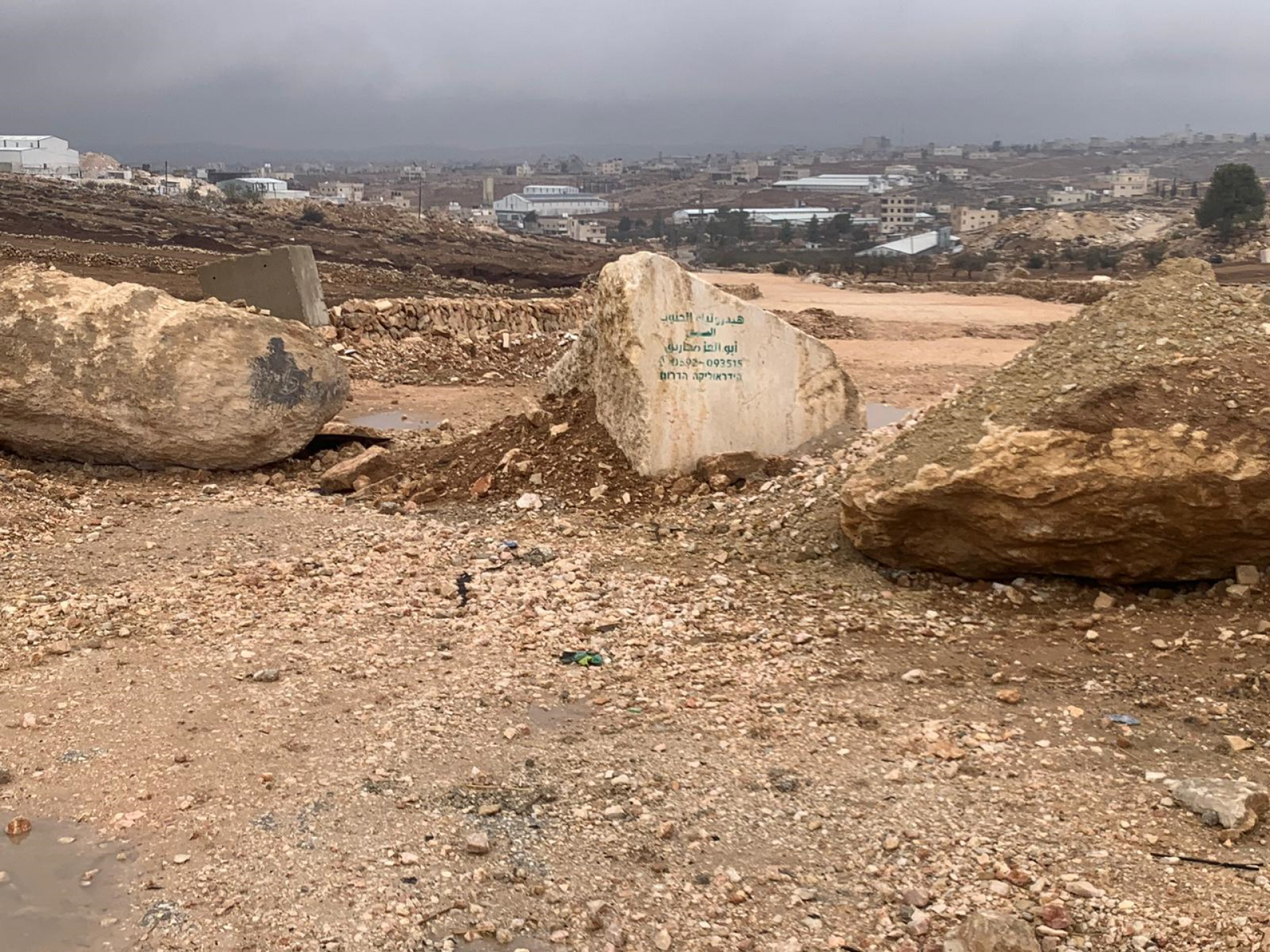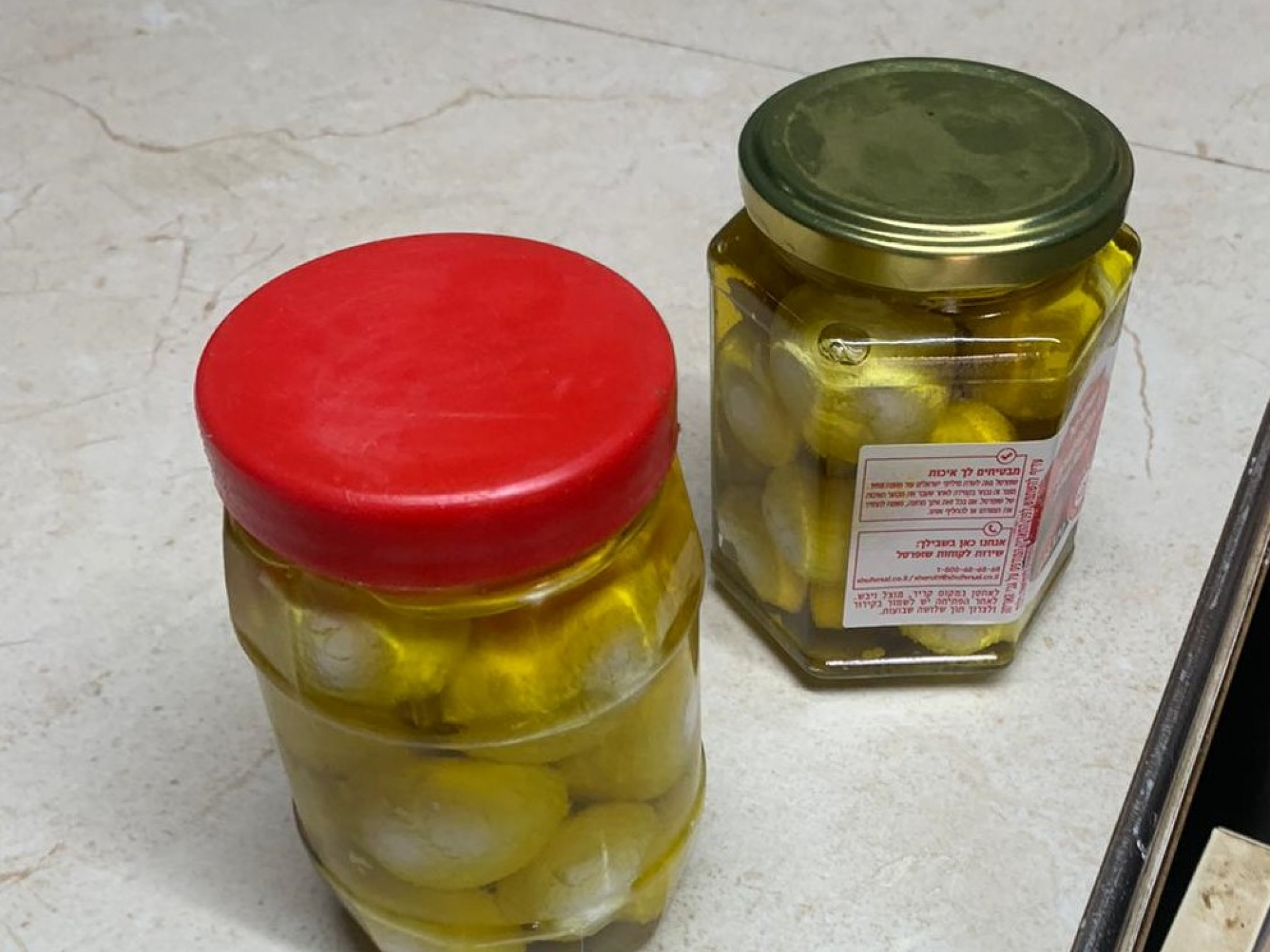Southern Hebron Hills – all roads to the Palestinian villages are blocked
East of apartheid roads in the South Hebron Hilla, all Palestinian settlements are blocked.
We drove on Route 60 and 317. We visited Susiya and Umm al-Khair.
A cloudy and rainy day. It is cold in the southern areas of Mount Hebron.
Route 317: It is now an apartheid road. Driving on it is prohibited for cars with Palestinian license plates. All the entrances to Palestinian settlements, besides At-Tuwani are blocked.
In Maktal Al-Salem, north of the road, in front of Meitar, the Israeli flag that settlers (probably) flew after the burning of the compound is still flying. Muhammad says that the residents told him that they are afraid of the settlers and do not dare to approach the destroyed compound in order to look for equipment that may have survived the fire. He heard the same story from Abu Safi, who is now reportedly recovering from his previous heart surgery (an expensive surgery that was only partially paid for by some kind of insurance, and the rest was helped by organizations).
Along the road, many I Israeli flags.
Samu’: the main entrance is blocked by boulders that cannot be moved by simple means. The entrance is also closed from Route 60. The only entrance to Samu’is now through Karma, from the north. Very far away. The entrance to Karma from road 60 is also usually closed. Sometimes the residents manage to open it. Cat and mouse games. On the hills around Samu’, you see new pillboxes. to increase supervision.
Susiya:
Everything around is blocked with boulders and piles of dirt. Even in the depth of the area, near orchards and fields, there are high piles of dirt, which will prevent any tractor or vehicle from going down or to come near the road. The residents left their vehicles inside the village, or outside it, on the side of Yatta. From the Yatta side, the distance is about two kilometres that must be covered on foot.
We visited Azzam and Wadha. Their premises are always pleasant and inviting. We were treated to fresh pita from the tabun with olive oil and thyme, and delicious tea. Wadha makes and sells white cheese balls in olive oil, olives and olive oil jars.
They say that the people in the village are fine. As far as the blockades are concerned, they manage to deliver food to people on foot. But there is a big problem of transferring food to animals. They have about fifty sheep. The food weighs over half a ton. You also have to move straw and hay, and without a car and a tractor it's really difficult.
Water: there is only what remains in the pits that were not destroyed by the neighbouring settlers. They bless the rain that falls during our visit. The water is raised from the pits using a pump that transfers the water to the tanks placed at a height, from where it flows to the taps. In the summer they also have to buy water tanks, and save.
Harassment by the neighbouring settlers: A few days ago, settlers from Susiya entered the Jabor family's olive grove with their sheep and horses, beat the family members, destroyed trees. There are now no peace activists from outside, whose presence would deter settlers. Local activists are also lowering their heads, fearing the heavy hand of the security forces.
Brotherhood of Neighbours: Ancient Susiya lies less than two hundred meters from the village of Susiya. Azzam and others in the village were born in ancient Susiya. In ancient Susiya there is plenty of water and electricity. Only four settler families live there. There is a house there in which one room is still a room of the village where the Palestinian residents were born. This room was not destroyed. But the electricity and water from the ancient Susiya are not given to the residents of the Palestinian village of Susiya. Indeed, a good and generous neighbour.
Umm al-Khair (the side which is adjacent to the fence of the Carmel settlement):
We met Khalil and Ali. Then Aziz and Awwad joined. We sat with them in the Diwan, a meeting place ('shig' in Bedouin language). There is a large room, mostly bare, with a few mattresses around, a few chairs, and a chimney stove for heating, in the centre. The fire in the oven is fed with bricks (perhaps mud bricks). We sit around the stove. Warm and cozy for us. They say that since they filed a complaint about the previous invasion by the Carmel settlers there has been silence from the settlement. But, there is the army.
Army patrols: three times a day, a military vehicle arrives with four soldiers, parked in the centre between the houses and the tents at the entrance, then the soldiers get out of the vehicle and walk around in silence in all the corners of the compound. In the evening, with flashlights. They don't answer questions, don't refer to the residents, just shine a light on all directions and around. When the tour ends, they leave without a word. The children are afraid of the soldiers. The residents are frustrated, silent, do not dare. Khalil leads us along the soldiers' patrol route, and says: Try to imagine the feeling, if this happened in your home. What are they looking for here? We are simple people who just want to live and make a living.
Aziz is an engineer who normally works for the Palestinian Authority in Hebron. But now all entrances to Hebron are closed to vehicles. That's why he stays at home. There is no salary because the Authority does not pay.
Ali is the director of a school in Khirbet a-Duqaiqa, a small Bedouin village towards the east (on the road to Hashem al-Darraj). The school is closed because the teachers are from Yatta cannot come, because all the bed exits are blocked. The Palestinian Authority does not pay them either.
As you know, the Palestinian Authority is not paying salaries now because Israel stopped the transfer of the tax money it collects for the PA. In fact, the collection for the PA is used by Israel as a pressure tool (the PA wanted to collect on its own, but Israel refuses to give up control over the collection of funds).
We also met Bob, an American from St. Louis, Missouri, who came as part of volunteering for an organization, the Center for Jewish Nonviolence (CJNV). Bob has stayed in the village intermittently, for about three or four years, with breaks. Will be happy to share his experiences, impressions and opinions with a press reporter or someone like that.
On the way back: Muhammad comments that in practice, Route 60 is also an apartheid road. All entrances and exits to Palestinian settlements on both sides are closed. Traffic is conducted separately, in a north-south direction, to the west of the road, traffic around Hebron, and to the east of the road, traffic around an Yatta.
We stopped in front of abandoned Zanuta. From the road it appears that only the school building (for the establishment of which there was a sophisticated struggle between the Palestinian residents and the security forces) remains standing. We don't dare to go inside, even though there is no obstruction here, because it is not allowed, and military vehicles are constantly patrolling the road. Suddenly we see fire smoke billowing over the school. Within seconds a military vehicle arrives with four soldiers. They interrogate us for our actions. We: we photograph what remains of the abandoned village. We tell them the history of the village in recent years of which they were not aware. But one of the soldier’s comments about the fire: the Palestinians always light a fire and then say that the settlers are harassing them. This is probably how the narrative of the settlers rescuing Masafer Yatta was built.
Summary: Apartheid roads. Palestinian villages are all blocked. We have no way of getting to the area of Khursa, Fuqeiqis and Negohot, because Hebron is blocked and everything to the south is blocked. The settlers can do there as they wish. We will try to update by phone. It is also not known about the fire at the school of Zanuta, because local activists are afraid to approach for fear of the army. This is how a regime of intimidation was built.


